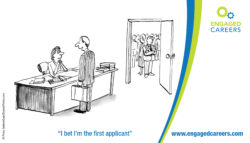Click to Apply…Job Hunting in the Digital Age

I was speaking with a recent university graduate the other day who bemoaned the fact his online applications went into the digital abyss resulting in radio silence. When I think back to my own first post-university job hunt I had to laugh at my experience of going to the printer, selecting the perfect paper, diligently researching companies at the library and mailing in my application. Ah, the good old days right?
The first hurdle for job hunters today is to get through the technology gauntlet of applicant tracking systems with robots scanning resume submissions for relevant keywords. In the digital age, with hundreds of applications for every job, hiring managers often rely on software filters to find the most qualified candidates based on their credentials and qualifications using keywords. For example, some employers will include 5 ‘must-have’ skills such as a bachelor’s degree, supervisory experience, customer service experience, advanced Excel and writing skills.
Keywords. Keywords. Keywords.
If you’re familiar with search engine optimization (SEO), you understand the importance of keyword density to search engine ranking. Similarly, keyword optimization within your resume and LinkedIn Profile is essential to get your name to the top of the pile.
The first step is to read the job description thoroughly and highlight keywords. Next, look at your own resume and see how many of the keywords match. A good tip is to create a list of “Skills and Abilities” and populate it with common keywords in your industry. For example, if you work in the tech sector, you should include all the software, hardware and applications you have experience working with. If you’re an accountant, include common keywords like accounts payable, receivable, budgeting, forecasts, etc. You get the idea.
LinkedIn Profile Optimization
Once you’ve updated your resume with keywords relative to your industry, it’s time to turn your attention to LinkedIn. Think of LinkedIn as your personal branding statement with an opportunity to create a more complete picture of your expertise and experience.
The first step is to review your current profile to evaluate your use of keywords. Take every opportunity to maximize keywords in the following sections:
- Professional Headline: 120 character limit.
- Summary: 2,000 character limit.
- Skills and Endorsements: 50 skills maximum
- Position Title: 100 characters.
- Position Description: 200 minimum and 2000 maximum characters.
Look up the profiles of your peers to see the language and keywords they are using to ensure you’re aligned with others in your industry. If you’ve applied for 100’s of jobs and have received zero responses, it’s time to rethink your strategy.
Go Old School and Offline
If you’re still coming up short despite your best efforts, it’s time get proactive and reach out to potential employers the old fashioned way. The Internet provides an unlimited opportunity to research potential employers, discover who works there and whether you have connections that could make personal introductions to key decision makers. Use LinkedIn to ask for introductions and book information meetings to explore your fit with potential employers. Taking this proactive step will set you apart from most other candidates who simply submit an application and wait for the phone to ring.